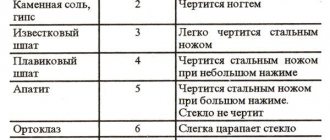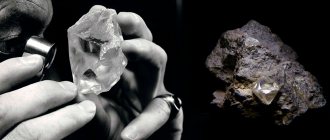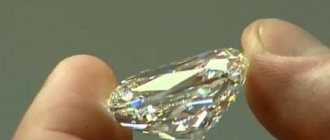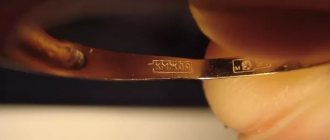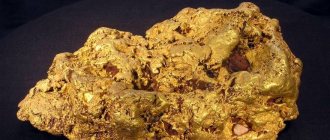Many people know that diamond is the hardest natural material in the world. Some have heard of or may have come across the concept of diamond coating or diamond heads on cutting tools. But what exactly is the concept of diamond hardness, and what does it relate to?
Diamonds
The concept of hardness and its measurement has long remained a rather controversial issue. For a very long time they could not develop a method by which it would be possible to determine the amount of this parameter. Until Mohs came up with the idea of measuring this parameter by trying to scratch one mineral with other minerals. If one of them was scratched by the others, then it was automatically assigned a lower hardness value. Taking a standard for each unit, he developed his own hardness scale with values from 1 to 10.
The hardness of a diamond was responsible for 10 points; talc became the standard for one hardness point. Another common gemstone is corundum, which is divided into rubies and sapphires and has an index of 9. Thus, this most common scale and corresponding values were fixed.
Why does diamond have such a high hardness rating? As it turns out, the chemical structure of diamond is pure carbon. The same carbon, which in its normalized state is graphite and whose hardness on the Mohs scale is equal to one.
Why then do they have such different properties if they consist of the same atom? This occurs due to chemical bonds and the structure of the crystal lattice. The carbon atoms in these two substances are connected differently to each other, which gives a different structure.
As you know, there is no material in nature that is harder than diamond. But recently, scientists have developed a synthetic substance, which, according to them, has this indicator by 58% more. This substance is called lonsdaleite. Lonsdaleite can withstand pressures that are 55 GPa greater than the hardest diamond can withstand. Its use is almost impossible due to its high cost. There is no particular need to use such material.
Other characteristics
If diamond is the hardest mineral, does that mean it can't be broken? Unfortunately, it is not. The fact is that in different directions of the crystal its hardness is not the same. Its cutting, grinding and sawing are based on this property.
Therefore, the strength of a diamond is low; a strong blow can cause it to break into pieces. This somewhat limits its use. High hardness makes it highly wear-resistant and abrasion-resistant, but does not guarantee that the diamond will not break.
It seems that if a diamond has such a high hardness, it must at least be very dense. In fact, its density is only about 3.5 grams per cubic centimeter. This is three times more than water, but, for example, six times less than gold.
Nevertheless, for a stone such density is sufficient, one might even say large, which also affects its strength. Diamonds have a characteristic shine and play of color, which is explained by such a parameter as the refractive index. Diamonds have a refractive index of approximately 2.4, which is the highest value for a gemstone. Another important parameter is dispersion. Dispersion is the difference in refractive index depending on the wavelength of the light used.
Mohs scale
The higher the dispersion index, the more pronounced the play of colors. For diamonds, this indicator is high, which gives it a unique shine. The combination of refraction and dispersion, as well as the hardness of the mineral, which allows it to be polished without the slightest flaw or crack, together make up the necessary set that makes this stone the most expensive in the world.
Diamond has another interesting property - it is characterized by the highest thermal conductivity, which is the highest among all solids. This allows us to consider it as a promising semiconductor for use in electronics. However, this is only possible if they learn to synthesize cheap diamonds. Silicon semiconductors can operate at temperatures up to 100 degrees Celsius, while diamond chips will withstand much higher temperatures.
Diamond does not dissolve in acids and alkalis. It has a low coefficient of friction in the air, which occurs due to the formation of absorber films on the surface of the stone. The melting point is 3500-4000 degrees Celsius under certain pressure conditions. If it is exposed to air at a temperature of about 860 degrees, the combustion process begins. If it is heated to a high temperature without access to oxygen, it turns into carbon in a few minutes.
Rockwell hardness test
Metals have a fairly large number of physical and mechanical properties that should be taken into account when using them for the manufacture of various products. Hardness is the ability of one material to prevent the penetration of another, harder material. A variety of testing methods have been developed to measure this indicator. Rockwell hardness (HRC) testing is often performed. This method has quite a large number of features, which we will discuss in more detail later.
Hardness scales
Rockwell's measure of hardness is designated HRC. During testing of various metals, 11 scales were developed, which differ in the ratio of the geometric dimensions of the tip and the applied load. It is worth considering that today not only diamond tips are used as a pressable body. Distributed:
- spheres made of hardened steel;
- balls made of carbide and tungsten alloy.
The designation is carried out using capital letters of the Latin alphabet.
Rockwell hardness scales
Why is it so important to consider the type of scale used? There are quite a few reasons:
- The type of pressed indicator depends on it. At the same time, there is a certain connection between the geometric shape and size of the indicator and the data obtained.
- Each type of pressed object has its own maximum load limit.
The results obtained are important in the manufacture of bearings and other critical elements used in the creation of cars or aircraft. The Rockwell hardness dimension is also taken into account when choosing products made from hardened steel.
Measurement equipment
At the time of development of the method under consideration for measuring hardness, there was no special equipment. After the importance of this physical and mechanical characteristic was established in mechanical engineering and other areas of industry, special equipment was developed, which is also based on pressing a ball or cone into the test object. Modern equipment allows you to control with high precision the amount of applied force and holding time. A hardness tester measures the hardness of, as a rule, small objects that are samples of the resulting workpiece. This is due to the very compact size of most models of the devices in question.
Measurement equipment
At the time of development of the method under consideration for measuring hardness, there was no special equipment. After the importance of this physical and mechanical characteristic was established in mechanical engineering and other areas of industry, special equipment was developed, which is also based on pressing a ball or cone into the test object. Modern equipment allows you to control with high precision the amount of applied force and holding time. A hardness tester measures the hardness of, as a rule, small objects that are samples of the resulting workpiece. This is due to the very compact size of most models of the devices in question.
The features of the equipment used include the following points:
- The test sample is usually placed on a table.
- The diamond tip is lowered using a weight lever.
- The important point is that the tip goes down smoothly. This is achieved by using a handle with an oil shock absorber.
- The holding time of the applicable load depends on the size of the test specimen. As a rule, the indicator is 3-6 seconds. The force of impact is also determined by the size of the workpiece.
- Important parameters are entered using a special programming console. Due to the fact that the equipment controls the applied force and holding time, the accuracy of the results obtained is quite high.
The equipment in question is produced by a fairly large number of different companies. At the same time, the cost of supply can fluctuate within a fairly wide range.
Hardness scales
Rockwell's measure of hardness is designated HRC. During testing of various metals, 11 scales were developed, which differ in the ratio of the geometric dimensions of the tip and the applied load. It is worth considering that today not only diamond tips are used as a pressable body. Distributed:
- spheres made of hardened steel;
- balls made of carbide and tungsten alloy.
The designation is carried out using capital letters of the Latin alphabet.
Rockwell hardness scales
Why is it so important to consider the type of scale used? There are quite a few reasons:
- The type of pressed indicator depends on it. At the same time, there is a certain connection between the geometric shape and size of the indicator and the data obtained.
- Each type of pressed object has its own maximum load limit.
The results obtained are important in the manufacture of bearings and other critical elements used in the creation of cars or aircraft. The Rockwell hardness dimension is also taken into account when choosing products made from hardened steel.
Rockwell glass hardness table
In the Hunting and Fishing , the question is How to approximately determine the hardness of a homemade knife. asked by the author Yergey Biryuchevsky, the best answer is: If the file catches slightly, less than 58, if it scratches bottle glass, more than 60.
Conversion table H B – HRC (Hardness Conversion)
(ratio of Brinell hardness to Rockwell hardness, determined by methods in accordance with GOST 8.064-79)
Hardness is the resistance of a body to the penetration of an indenter - another solid body. Hardness testing methods are divided into static and dynamic.
Static methods include methods for measuring hardness according to Brinell, Vickers, Rockwell, Knoop; to dynamic - methods of measuring hardness according to Shore, Schwartz, Bauman, Poldi, Morin, Grave.
Hardness measurements are carried out at 20±10°C.
Brinell hardness measurement
Brinell method
The Brinell method [named after the Swedish engineer J.A. Brinell] is a method of determining the hardness of materials by pressing a hardened steel ball with a diameter of 2.5 into the test surface; 5 and 10 mm with load P from 625 N to 30 kN. The Brinell hardness number HB is the ratio of the load (kgf) to the area (mm 2 ) of the print surface. To obtain comparable results of relative hardness, materials (HB over 130) are tested at a ratio of P:D 2 = 30, materials of medium hardness (HB 30-130) - at P: D 2 = 10, soft materials (HB 2 = 2.5. Tests according to the Brinell method, they are carried out on stationary hardness testers - Brinell presses , which ensure smooth application of a given load to the ball and its constancy when held for a set time (usually 30 seconds).
The Brinell method for measuring the hardness of metals is regulated by GOST 9012-59 “ Metals. Brinell hardness method : The standard establishes a method for measuring the Brinell hardness of metals with a hardness of not more than 650 units. The essence of the method is to press a ball (steel or hard alloy) into a sample (product) under the influence of a force applied perpendicular to the surface of the sample for a certain time, and measure the diameter of the indent after removing the force. GOST 9012-59, in particular, defines the requirements for the selection of metal samples for measuring Brinell hardness - sample size, surface roughness, etc.
Rockwell hardness measurement
Metals have a fairly large number of physical and mechanical properties that should be taken into account when using them for the manufacture of various products. Hardness is the ability of one material to prevent the penetration of another, harder material. A variety of testing methods have been developed to measure this indicator. Rockwell hardness (HRC) testing is often performed. This method has quite a large number of features, which we will discuss in more detail later.
Rockwell hardness of glass
If you have any problems, please let us know by sending an email to: [email protected] . Thank you!
SCHEDULE
Our office opening hours:
Mon-Fri: 9:00 – 18:00 Sat-Sun: CLOSED
LOG IN TO ACCESS EXTRAS. FUNCTIONS
REGISTRATION
FORGOT YOUR PASSWORD?
- home
- ARTICLES
- Hardness. Rockwell, Brinell, Vickers hardness testing
Tuesday Apr 07th, 2020
Measurement technique
The Rockwell method of determining metal hardness is used when it is necessary to test a workpiece of small thickness. In addition, the hardness of the surface layer of a product, for example, one that has undergone hardening or a cementing process, is checked in a similar way.
The hardness of metals is determined by the Rockwell method as follows:
- The method is based on pressing a harder object into the subject. For this, a special diamond tip is used, which has the shape of a regular pyramid.
- The load is applied to the tip for a certain time. In this case, the holding time and load magnitude can vary significantly. According to established standards in GOST 9013-59, the load can be from 1 to 100 kgf. At the same time, specific values from this interval are specified.
- The resulting diamond cone impressions are measured. The most important indicators in this case are the size of the diagonals of the remaining print.
Rockwell hardness measuring principle
The obtained data is checked against table values, which take into account the magnitude of the applied force and the holding time. The method under consideration makes it possible to obtain the hardness indicator in its own conventional units.
The measurement process can be divided into several stages:
- The scale type is determined.
- A suitable indicator is installed. It is important to choose an indicator that will match the type of scale installed.
- Two trial tests are carried out, which are necessary to correct the operation of the equipment used.
- A preload of 10 kgf is applied.
- The main load is applied and a certain period is maintained, which allows you to obtain the maximum value.
- The load is removed and the result is read.
Modern equipment can significantly simplify the process and increase the accuracy of the results obtained during measurements.
Measurement technique
The Rockwell method of determining metal hardness is used when it is necessary to test a workpiece of small thickness. In addition, the hardness of the surface layer of a product, for example, one that has undergone hardening or a cementing process, is checked in a similar way.
The hardness of metals is determined by the Rockwell method as follows:
- The method is based on pressing a harder object into the subject. For this, a special diamond tip is used, which has the shape of a regular pyramid.
- The load is applied to the tip for a certain time. In this case, the holding time and load magnitude can vary significantly. According to established standards in GOST 9013-59, the load can be from 1 to 100 kgf. At the same time, specific values from this interval are specified.
- The resulting diamond cone impressions are measured. The most important indicators in this case are the size of the diagonals of the remaining print.
Rockwell hardness measuring principle
The obtained data is checked against table values, which take into account the magnitude of the applied force and the holding time. The method under consideration makes it possible to obtain the hardness indicator in its own conventional units.
The measurement process can be divided into several stages:
- The scale type is determined.
- A suitable indicator is installed. It is important to choose an indicator that will match the type of scale installed.
- Two trial tests are carried out, which are necessary to correct the operation of the equipment used.
- A preload of 10 kgf is applied.
- The main load is applied and a certain period is maintained, which allows you to obtain the maximum value.
- The load is removed and the result is read.
Download GOST 9013-59
Modern equipment can significantly simplify the process and increase the accuracy of the results obtained during measurements.
